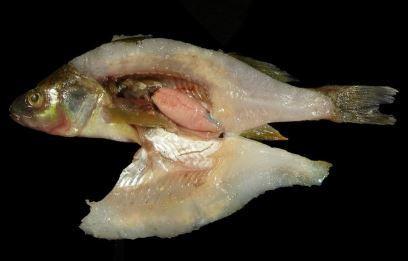The St. Croix River Association will be posting guest posts on our blog this summer! They will cover a broad range of topics including; invasive species, the watershed, great tips to help take care of the environment while boating, and more. We hope you enjoy learning more about the beautiful environment you boat in!
Fast Facts about the River
The St. Croix River has a rich fish community that draws anglers from throughout the region. Fish include walleye, sauger, smallmouth bass, muskie, catfish, and lake sturgeon, among others. Non-native and introduced parasites such as Heterosporis can cause large-scale mortality among our native fishes (to learn more about some of the research on Heterosporis, visit: http://tinyurl.com/hva3qt9). You can also visit the MN DNR website.
What Does It Look Like?
White or “opaque areas” in the uncooked fish fillet. White regions on the fillet that resemble cooked meat.
Fish Species Affected
Predominantly seen in yellow perch, this disease has also been detected in walleye, northern pike, trout-perch, burbot, pumpkinseed, sculpin and rock bass.
Life Cycle
Heterosporis spreads when fish pick up spores from the water or eat infected fish or carcasses. Little is known about the life cycle. This parasite may spread by infected fathead minnows sold as bait.
Where is the Disease Found?
Heterosporis infections in Minnesota have been documented in Big Sand, Winnibigoshish, Leech, Clitherall, Vermilion, Mille Lacs, Bear, Moose, Cass, Andrusia, and Gull lakes. The disease is also found in Canada.
Is it Safe to Eat?
Based on studies by the Center for Disease Control in Atlanta, there is no evidence that Heterosporis can infect people. It is thought, but not proven; that thoroughly cooking infected fish will destroy spores. Either cook the fish thoroughly or discard the flesh by burning or burying it. Don’t throw it back into the lake.
How can I Prevent the Spread?
To reduce the risk of spreading Heterosporis, never release unused minnows into lakes. If you see opaque-looking patches when you fillet a fish, report it to the DNR by calling (888) 646-6367.
Effects on Fish
Heterosporis is a microscopic parasite that infects muscle tissue of fish. These parasites produce millions of spores, which gradually destroy muscle tissue. These spores can eventually replace almost all muscle tissue.
Disposal of Unused Portions
Unused or uneaten portions of fish should be buried or disposed of with household waste. Fish entrails should never be discarded back into the lake.
Ways to Protect the River
Do not move live fish or water between water bodies. Diseases and parasites are spread by moving infected water, equipment, and fish from one body of water to another.
The St. Croix River Association is dedicated to preventing the spread of aquatic invasive species as we protect, restore and celebrate the St. Croix River and its watershed.
Learn more about our programs and ways you can get involved by visiting our website at stcroixriverassociation.org.
Note: The information in the article above is from both the MN DNR and the St. Croix River Association.


